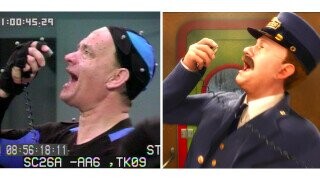‘The Polar Express’: How Robert Zemeckis Turned Tom Hanks Into An Uncanny Valley Monster

Robert Zemeckis has done a lot of good work in the art of filmmaking. He created the Back to the Future movies alongside Bob Gale. He directed the groundbreaking live-action animation Who Framed Roger Rabbit. He made the first ever movie that used CG to alter a human body (Death Becomes Her), and he made Tom Hanks everyone’s favorite “Journey Man” by casting him in Forrest Gump, and then in that movie where Hanks gets super attached to a volleyball.
On the negative side of the ledger, though, he also turned Hanks into an expressionless, taxidermy-looking animation.

Warner Bros. Pictures
Don't Miss
The 2004 animation about a boy who doesn’t believe in Santa until he hears a bell ring was, well, a movie. While there were scenes that were surely better than others, the story was thin, and the sound at times just a tad too screechy. All of that could be forgiven, at least, as many a kid would probably still enjoy the Christmas movie that, quite early on, kinda remind us of Snowpiercer — what with a kid put in charge of driving the train because apparently, it's just that easy. What can’t be forgiven — or should we rather say, forgotten — is the fact that Hanks has never looked more dead on screen, and not for a lack of effort. By God, the man did try.
The whole idea of turning The Polar Express children’s book into a movie came from Hanks, which means the actor only has himself to blame for ending up looking like a Christmas stocking sporting a mustache. When Hanks optioned the book, part of the sale's conditions was that the story of some kids riding a train with a bunch of adult strangers couldn’t be turned into an animated movie. Zemeckis, however, didn’t think that The Polar Express would work as a live-action rendition.
Instead, the filmmaker decided to create a brand new way of making movies (and nightmares) by using performance capture — a supposedly evolved version of motion capture that was developed for the project and used sensors to digitally record a performer’s every little movement — and combining it with stage acting and computer graphics to create animation with actors doing human things in front of a camera.
In hindsight, a live version of Hanks playing multiple roles with his acting caliber would probably have been better than seeing him (and everyone else) transformed into uncanny valley characters who look less human and more like three raccoons in a trench coat.
In fairness, it was the first of its kind, and the movie was listed by Guinness World Records as the “first film to entirely use the Performance Capture technique.” To expect the use of any new technology to immediately be good and perfect is perhaps unfair.
Just three years later, Zemeckis would use the same technology to make Angelina Jolie look like a wax doll in Beowulf:
And two years after that, in 2009, Zemeckis did a Scrooge movie that would at least make Jim Carrey look kind of okay, but only because they rendered his face to look like a wrung-out dishcloth.
Let’s also not forget the Zemeckis-produced 2011 movie in which Seth Green plays a 9-year-old with eyes as big as tennis balls whose mom gets captured by Martians because he didn’t want to eat his broccoli.
Sure, you could definitely see, uh, small improvements between The Polar Express and Mars Needs Moms, but the lack of bigger facial movements combined with the fact that, you know, video games today look the way they do just make these films look worse with every passing year.
After Mars Needs Moms failed miserably at the box office — and became yet another Zemeckis movie accused of scarring man and child with its uncanny appearances — it was ultimately decided to disband ImageMovers Digital (the Disney facility specially created for Zemeckis to do his performance capture thing), and everyone moved on to greener pastures of Hulks and Gollums.
Which we should all be grateful for since the project following that Mars movie was supposed to be a Yellow Submarine remake. No one needs to have nightmares about actors playing Beatles members singing songs about Lucy’s and Eleanor’s while staring at us with eyes deader than, well, half of The Beatles.